Longtime readers will know that I drive a 2017 Mazda CX-5 and am rather a fan of Mazda vehicles. It's been a solid, reliable vehicle that's comfortable for four adults and has sufficient cargo space for my trips to the hardware store and airport. I share this up front so you know my biases, though I'm a fan of modern design and like just about every major manufacturer's product lineup, with some caveats. Other than specs, car reviews are inherently subjective, so regardless of what review you're watching or reading, it's just their opinion. Your experience might be quite different, which is how I have friends who are passionate about vehicles that I find meh.
I'm also considering replacing my CX-5 to get the latest generation of tech and safety equipment and more sophisticated electronics, so I am keeping a close eye on favorite brands and models. When Mazda offered me a week with the 2025 Mazda CX-30 2.5 Turbo Premium Plus, I was most interested; the CX-30's a bit small for my personal needs, but the chance to see what almost a decade of evolution has brought to the Mazda design was very appealing.
The vehicle they dropped off was even the same color as my CX-5: Snowflake White Pearl:
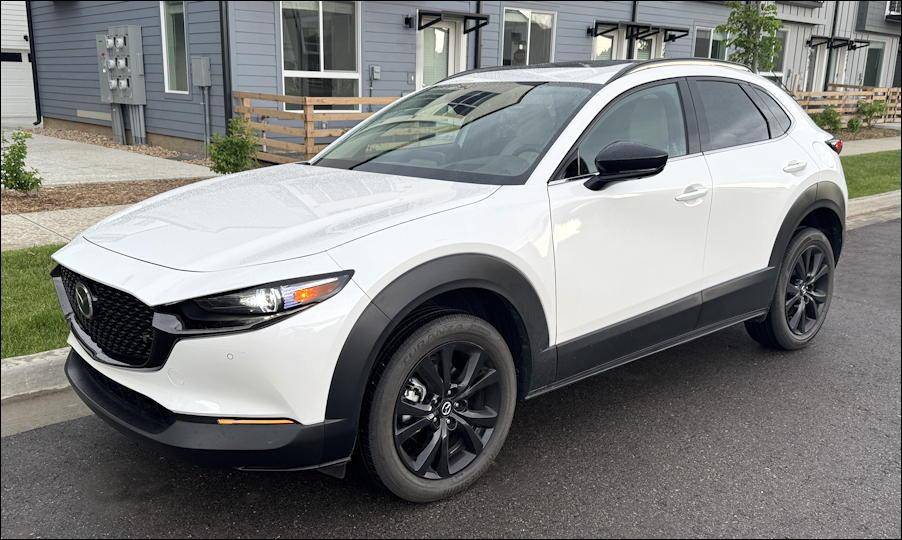
It's very attractive and part of what Mazda calls its Kodo: Soul of Motion design family. Kodo was introduced in 2010. The CX-30, which serves as a crossover alternative to the more sedate Mazda 3, wasn't introduced until 2020. For reference, the CX-5 was introduced in 2012, and the Mazda 3 goes back to 2004. To my eye, it looks a lot like a CX-5, even to the same front grill design and general profile. It's a bit lower in the back, and none of the CX-5 models have that big black trim along the wheel wells and lower portion of the doors.
Get inside and it's much more obvious that the CX-30 is a small crossover, with tight rear legroom (as I'll show and discuss in a few minutes) and limited cargo space. For people who drive solo or are part of a couple, however, it's like a mini SUV that can be a great option. Let's look inside...
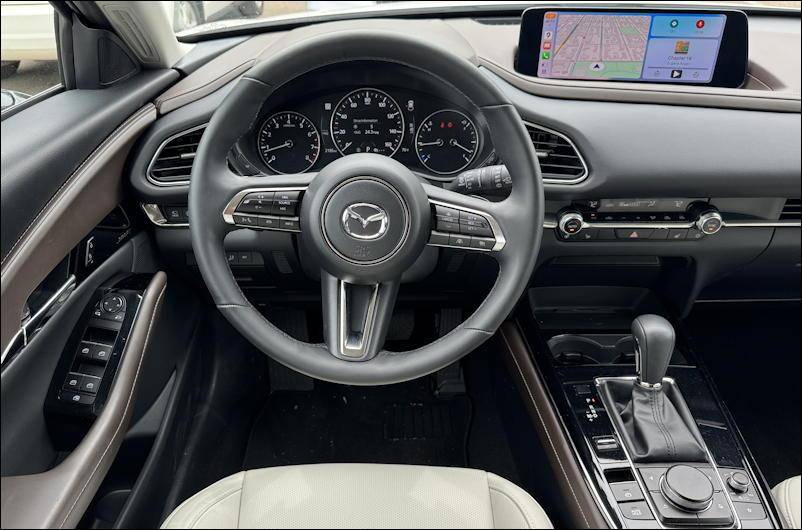
The CX-30 sports a large 10.3-inch infotainment display and a big, easily read main gauge cluster, along with a straight gearshift right where a driver would expect it: on the center console. There are lots of buttons and controls, but they are thoughtfully deployed so that the first impression of the dash is that it's uncluttered. The placement of the climate control vents is also excellent: too many modern cars have them in odd spots or so small that their functionality is limited.
Most of the hidden controls that contribute to the uncluttered look turn out to be tucked behind the driver's left knee:

Some of these are rarely used - like driver's seat setting preferences - but at least one of them, the camera view button, is awkward to utilize when pulling into a parking spot. Shift into reverse, and the camera appears on the display, but in a forward gear, you need to push this button. This is one of several design choices that marred my experience with the CX-30.

More frustrating was the placement of the cup holders. On my CX-5 the cupholders are on the far side of the gear shift and infotainment control knobs, but in this vehicle, they're tucked under the climate controls. Which works great unless you have a water bottle or tall cup, in which case, they push against some of the climate controls. When my daughter put her Stanley cup in the cupholder, for example, it pushed firmly against the seat warmer button. My water bottle was a non-starter for the same reason. I know, it's relatively trivial, but don't engineers at Mazda Japan have water bottles for testing?
You'll also notice in the above photo the Qi wireless charging spot. It worked with my iPhone 15 Pro about 50% of the time, but too often my phone wouldn't charge at all. In fact, at one point in my seven day loan the car "forgot" my phone and I couldn't even connect via Bluetooth. I had to delete my phone from the car's electronics system, delete the car from my phone's Bluetooth connection list, and re-pair them for wireless CarPlay to return.
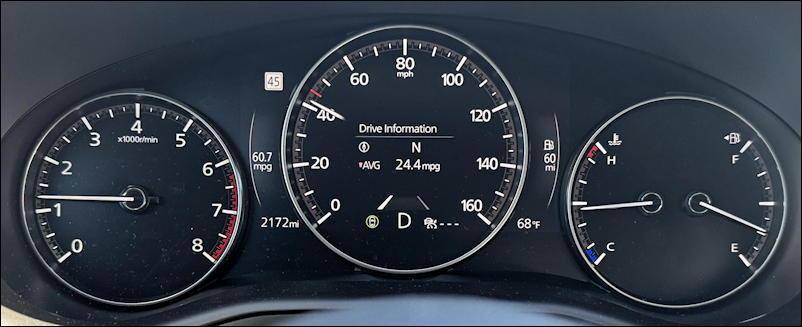
I really liked the main gauge display with its big, easy-to-read dials. Do you need a tachometer on an automatic car? Apparently, yes. The red tick on the speedometer is a visual indicator of the current speed limit, an elegant design choice. Notice, however, the range: With just over 1/4 tank, the car calculates 60 miles until empty, suggesting about a 250-mile range with a full tank, which is fairly low, though not completely uncommon with this class of subcompact. (Do the math from the EPA numbers and its 12.7 gallon tank and range should be just over 300 miles. Go figure)
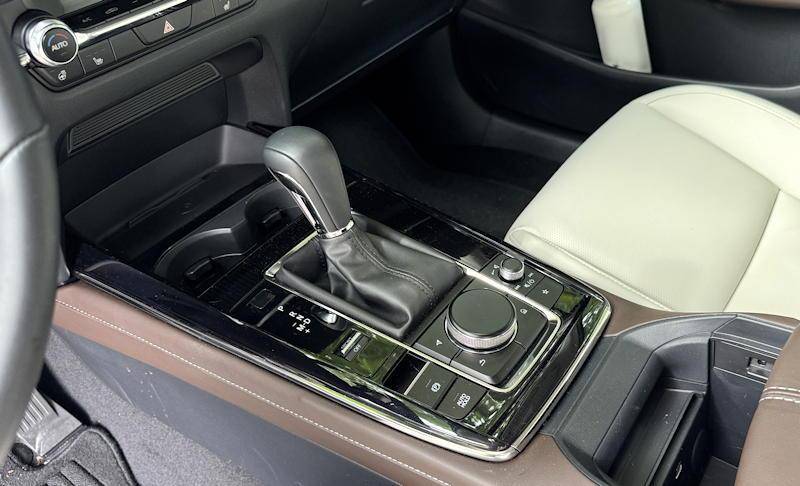
On a more positive note, I still really appreciate the Commander Control infotainment control knobs and dials on the center console. It's the best design in the industry and allows easy control of everything on the infotainment screen without ever taking your eyes off the road. Barely visible in the above photo, there's a control just above the gear labels that allows shifting into sport mode.
Sport mode offers a fun, zippy drive experience that shows off the agility of the 2025 Mazda CX-30 Turbo. Even in regular drive mode, it's a fun and sporty vehicle to drive with its 2.5L turbocharged Skyactiv-G engine and 6-speed transmission. I was a bit disappointed by the 23.7 mpg (EPA ratings are 22/30 mpg). Even my 2017 CX-5 is more fuel efficient. Mazda is being very deliberate with its implementation of hybrid and PHEV technologies; there are no announced plans for a hybrid CX-30 at this point.
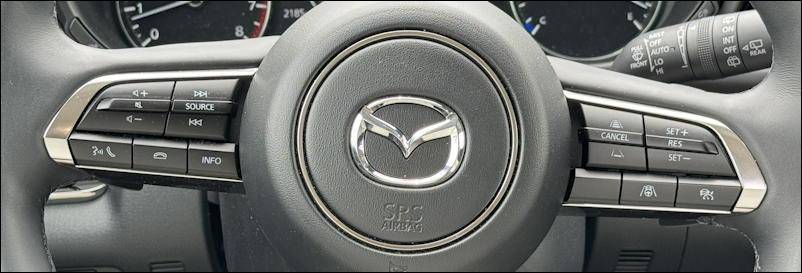
The steering wheel controls are symmetric and easy to figure out, with adaptive cruise control on the right and infotainment controls on the left. And no paddle shifters! If you're looking at the logo in the center and thinking it's reminiscent of a bird in flight, you're correct! It's a stylized "M" that's also supposed to capture the idea of wings in flight.
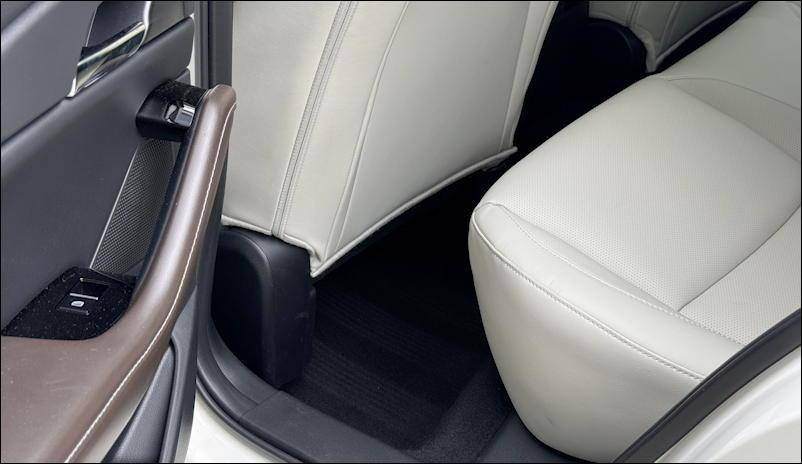
Earlier I mentioned the rear legroom. Now you can see it up close. This is with the front seat not all the way back, and it's still going to be a mighty cozy fit for anyone teen or older without further seat adjustments for comfort. You can, however, see the tri-tone color scheme of the interior, with cream seats, black rugs, and brown on the door armrest. This is the white/brown color scheme; the black shows up similar to how the exterior is white, but there's a big band of black along the lower portion of the car body.
Swinging into the very back, there's decent cargo space for a vehicle this size:

It also has a 60/40 foldable rear seat and lower-profile rear headrests to make that easy. Under the bottom carpet is a full-size spare, which many people will appreciate:

That portion with the Bose logo? That's the subwoofer! In fact, the Bose 12-speaker premium audio system has great sound, a definite benefit to this comfortable car.

There's a lot that Mazda's got right with this subcompact, from its Kodo design to the many top safety features and the Commander Console that makes interacting with the infotainment system while driving a breeze. There are a lot of surprising quirks in the design too, as I have explored in this review. Are any of them show-stoppers? Not in my opinion, but perhaps the next iteration can address a few of them to improve the vehicle?
2025 Mazda CX-30 2.5 Turbo Premium Plus, powered by a 2.5L Skyactiv-G turbo engine and 6-speed transmission. BASE PRICE: $36,950.00. Options: Premium Paint, Rear Bumper Guard. AS DRIVEN: $38,955.00.
Disclaimer: Mazda loaned me this vehicle for a week in return for this candid write-up and review. This article originally appeared on PlanetDave.com with the title 2025 Mazda CX-30 2.5 Turbo Premium Plus Gets It Mostly Right and is republished with permission.
Hey Dave Taylor wants you to share this!

